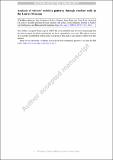Analysis of visitors’ mobility patterns through random walk in the Louvre Museum
Author(s)
Yoshimura, Yuji; Sinatra, Roberta; Krebs, Anne; Ratti, Carlo
Download12652_2019_1428_ReferencePDF.pdf (1.610Mb)
Open Access Policy
Open Access Policy
Creative Commons Attribution-Noncommercial-Share Alike
Terms of use
Metadata
Show full item recordAbstract
This paper examines visitors’ sequential movements and their patterns in a large-scale art museum. Visitors’ available time makes their visiting styles different, resulting in dissimilarity in the order and number of visited places and in path sequence length. Since the probability of the appearance of short combinations of nodes is higher than that of long combinations of nodes, shorter path sequences tend to appear more frequently than longer path sequences. This prevents us from evaluating the strength of visitors’ mobility patterns, independent of their path sequence length. In order to solve this problem, we propose the random walk simulation model and compare the results with observed data. A random walk is a minimalistic model providing a reference line for the frequency of sequences as induced by the graph structure of the museum. The random walk simulations can therefore provide us with the probability of transitions between nodes and hence with the probability of each path of a given length. Thus, it enables us to compare the frequency of different path sequence lengths in the same framework. Our results indicate that short-stay visitors exhibit stronger patterns than long-stay visitors, confirming that short-stay visitors are more selective than long-stay visitors in terms of their visiting style. This is suggestive of the informal learning settings in which visitors shape their experiences through exploration in space.
Date issued
2019-08-28Department
Senseable City LaboratoryPublisher
Springer Science and Business Media LLC
Citation
Yoshimura, Y., Sinatra, R., Krebs, A. et al. Analysis of visitors’ mobility patterns through random walk in the Louvre Museum. J Ambient Intell Human Comput 15, 1643–1658 (2024).
Version: Author's final manuscript
ISSN
1868-5137
1868-5145
Keywords
General Computer Science